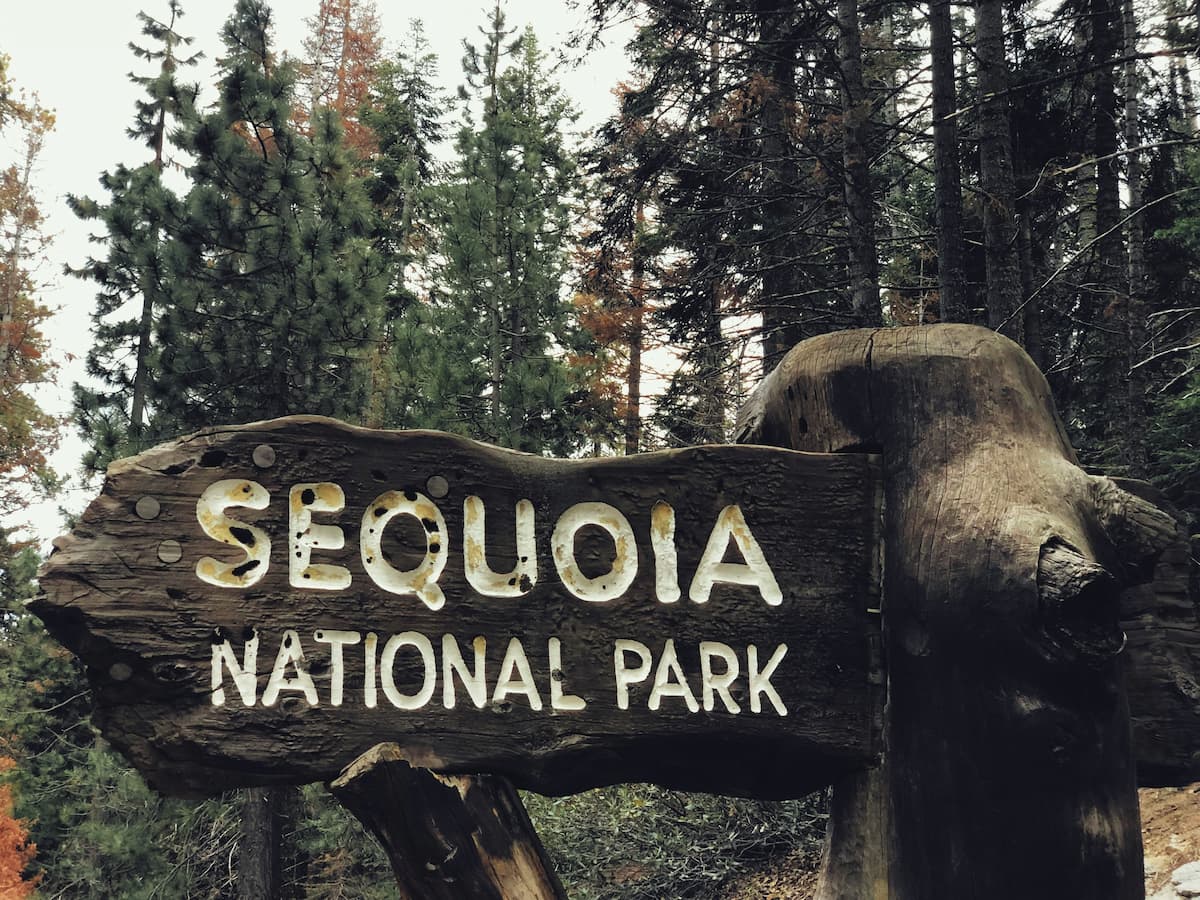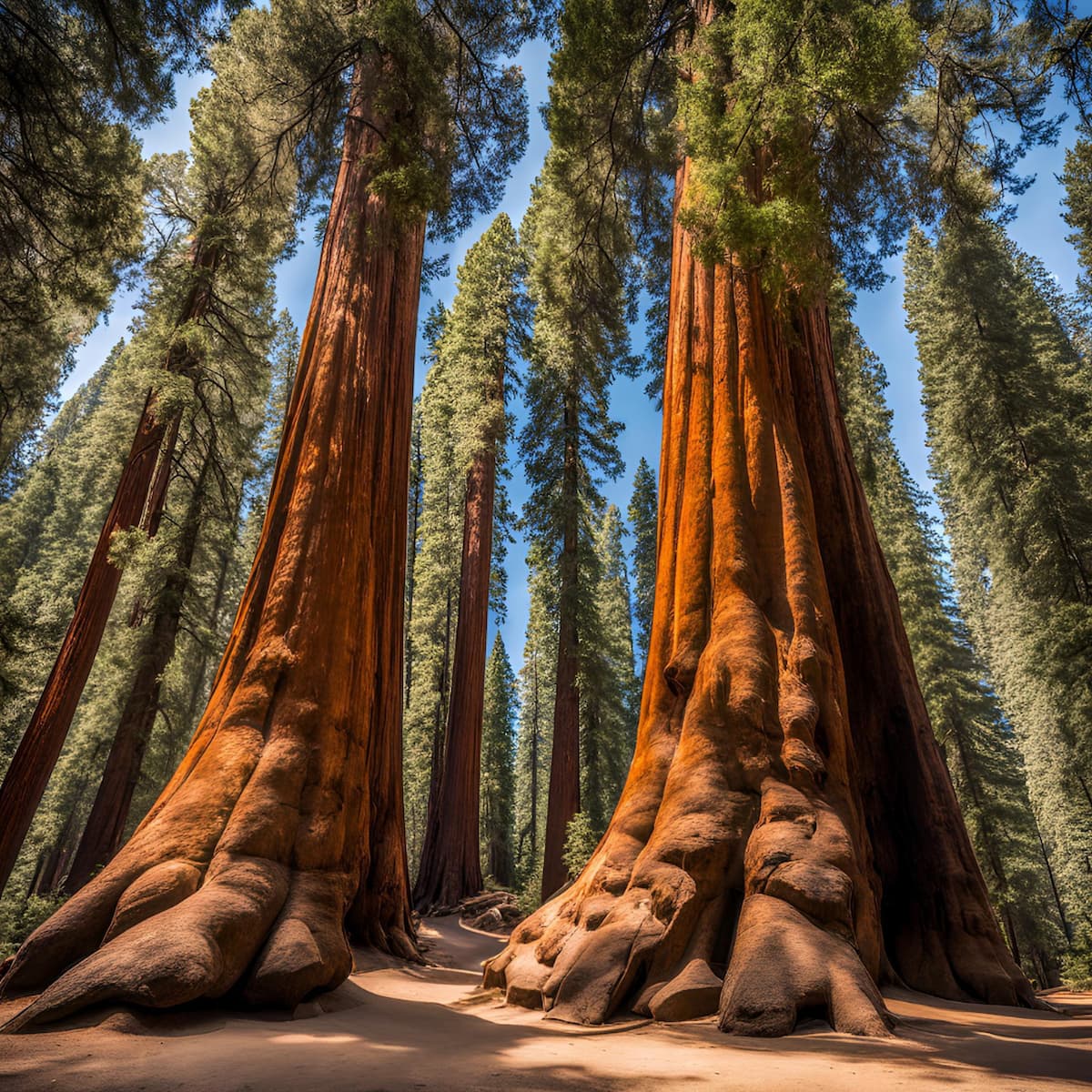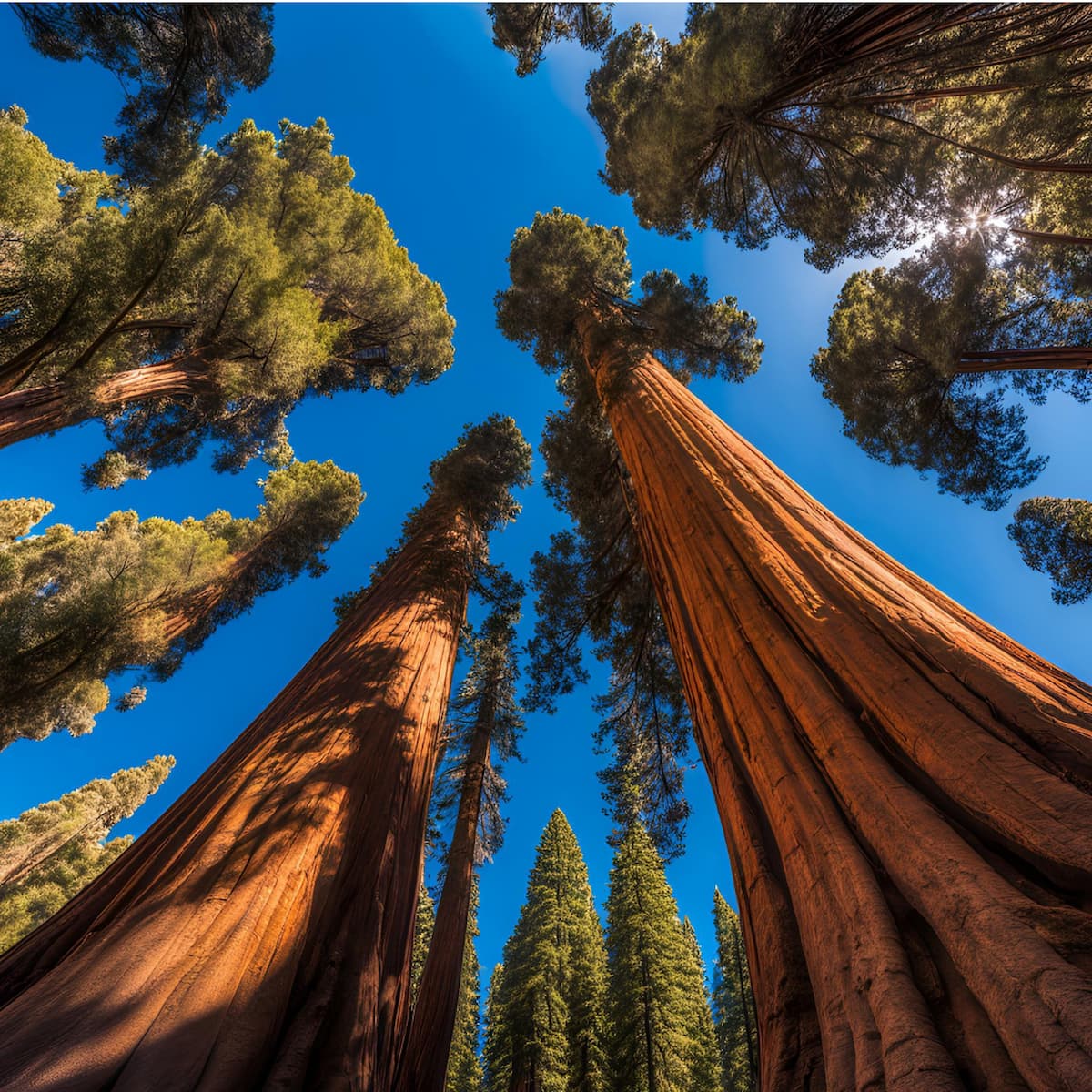
Watch short for this article (5 slides)
Land of Giants: Exploring Sequoia National Park's Ancient Trees and High Sierra Peaks
In the southern reaches of California's majestic Sierra Nevada mountain range lies Sequoia National Park, a realm renowned for hosting living organisms of truly staggering proportions – the giant sequoia trees. Established in 1890 as America's second national park, Sequoia was created primarily to protect these colossal trees from logging. However, its wonders extend far beyond the ancient groves. Jointly administered with adjacent Kings Canyon National Park, Sequoia encompasses a vast wilderness of dramatic elevation changes, from warm foothills to alpine peaks, including the highest point in the contiguous United States. It's a place where visitors can walk among Earth's largest trees by volume one moment and gaze upon rugged, glacially carved High Sierra landscapes the next, offering a profound connection to nature's scale and endurance.

Photo by James Lee on Unsplash - Sequoia National Park protects some of the world's most massive trees.
From Threatened Giants to Protected Treasure: Park History
Long before its designation as a national park, the lands within Sequoia were home to Native American groups, primarily the Mono (Monache) people, who utilized the region's resources seasonally. European-American exploration began in the mid-19th century, but it was the logging industry's arrival in the 1880s that spurred urgent calls for preservation. Loggers began felling the immense sequoias, viewing them primarily as timber resources despite the wood's brittle nature making it poorly suited for construction.
Conservationists, alarmed by the destruction of these irreplaceable natural monuments, campaigned vigorously. Figures like George W. Stewart, editor of the Visalia Delta newspaper, and members of the Sierra Club (though John Muir's primary focus was initially Yosemite) advocated for federal protection. Their efforts succeeded when President Benjamin Harrison signed legislation establishing Sequoia National Park on September 25, 1890, specifically to safeguard the giant sequoia groves from logging. Just a week later, General Grant National Park (protecting the General Grant Grove) was also established nearby; these parks were later joined and expanded, eventually leading to the joint administration of Sequoia and Kings Canyon National Parks.
Walking Among Titans: The Giant Sequoias (Sequoiadendron giganteum)
The park's main attraction remains the awe-inspiring giant sequoia trees, the largest living things on Earth by volume.
- Defining Characteristics: These conifers are characterized by their immense size, reaching heights over 300 feet (91 meters), trunk diameters exceeding 30 feet (9 meters), and lifespans often surpassing 3,000 years. Their distinctive features include enormous, tapering trunks, thick, deeply furrowed, cinnamon-red bark (which can be up to 2 feet thick and provides crucial fire resistance), and massive, high-held branches forming a rounded crown.
- Largest Tree on Earth: The General Sherman Tree: Located in the heart of the Giant Forest, the General Sherman Tree holds the title of the world's largest living tree measured by trunk volume. While not the tallest or widest, its sheer bulk is staggering. Key statistics include:
- Estimated Age: Around 2,200 years old
- Height: Approximately 275 feet (83.8 meters)
- Circumference at Ground: Over 102 feet (31 meters)
- Estimated Trunk Volume: Over 52,500 cubic feet (1,487 cubic meters)
- Other Notable Groves and Trees:
- Giant Forest: Home to General Sherman and roughly half of the world's largest sequoias, interconnected by trails like the Congress Trail (a relatively easy loop showcasing numerous giants).
- Grant Grove (Kings Canyon NP): Technically in the adjacent park but often visited in conjunction via the Generals Highway, this grove contains the General Grant Tree. Designated as the "Nation's Christmas Tree," it's the third-largest tree by volume and features an exceptionally wide base.
- Sequoia Ecology and Fire Adaptation: Giant sequoias thrive in a specific ecological niche: mid-elevations (typically 5,000-7,000 feet / 1,500-2,100 meters) on the western slope of the Sierra Nevada, requiring ample moisture (often from snowpack) and sunlight. They possess remarkable adaptations to fire, which is a natural and essential process in their ecosystem:
- Thick, Insulating Bark: Protects the living cambium layer from moderate fires.
- Elevated Crowns: Mature trees often shed lower branches, keeping flames on the ground away from the main canopy.
- Serotinous Cones: Sequoia cones often remain closed and green on the tree for years, requiring the heat from a fire (or sometimes insect activity or drying) to open them and release seeds onto the nutrient-rich ash bed created by the fire, which also clears competing vegetation.

The General Sherman Tree is the world's largest tree by volume, located in the Giant Forest.
Beyond the Giants: Exploring the High Sierra Wilderness
Sequoia National Park protects a vast expanse of rugged High Sierra backcountry, offering starkly beautiful alpine scenery contrasting with the forested groves.
- Dramatic Elevation Gradient: The park rises steeply from foothills around 1,300 feet (400 m) to the towering peaks of the Sierra crest, creating diverse life zones.
- Mount Whitney: The Roof of the Contiguous US: The summit of Mount Whitney, at 14,505 feet (4,421 meters), is the highest point in the lower 48 states. While the peak technically sits on the boundary between Sequoia National Park and the Inyo National Forest, the most popular hiking route (the Mount Whitney Trail) begins outside the park on the eastern side of the Sierra (managed by Inyo NF and requiring a highly competitive lottery permit). Access from the western (Sequoia) side involves much longer, multi-day backpacking trips.
- Granite Domes and Peaks: The high country features glacially-carved granite landscapes, including domes like Moro Rock (offering spectacular panoramic views via a steep stairway climb) and numerous rugged peaks accessible via hiking trails.
- Crystal Cave: A Marble Marvel: Unlike the granite dominating the surface, Crystal Cave is a beautiful marble cavern (metamorphosed limestone) adorned with intricate formations like stalactites, stalagmites, flowstones, and draperies. Accessible only via guided tours (tickets purchased in advance recommended, typically operates seasonally May-September), it offers a glimpse into the park's subterranean geology. Temperatures inside remain a cool ~48°F (9°C) year-round. (Source: Sequoia Parks Conservancy - Crystal Cave)
- Kern Canyon: One of the deepest canyons in North America, carved by the Kern River, lies largely within the park's remote southern backcountry, accessible primarily to experienced backpackers.
- Alpine Lakes and Meadows: The high country is dotted with pristine glacial lakes (like Pear Lake, Heather Lake) and subalpine meadows (like Alta Meadow), often carpeted with wildflowers in summer, accessible via trails like the Lakes Trail or Alta Peak Trail.
Wildlife Encounters: From Bears to Birds
The park's diverse habitats support a rich array of wildlife adapted to different elevations.
- American Black Bears: Sequoia has a healthy population. While sightings can be exciting, bears are wild and potentially dangerous. Visitors MUST store all food and scented items properly in provided bear-resistant food lockers (bear boxes) at campsites and trailheads, or using approved bear canisters in the backcountry. Never feed bears. Make noise while hiking to avoid surprising them. (Source: NPS - Bear Safety)
- Mule Deer: Frequently seen, especially grazing in meadows or near developed areas during early morning and late evening (crepuscular activity).
- Smaller Mammals: Marmots, pikas (in high-elevation rock fields), squirrels (including Douglas squirrels and golden-mantled ground squirrels), chipmunks, and occasionally more elusive animals like bobcats or mountain lions inhabit the park.
- Birdlife: Over 200 bird species have been recorded. Look for Steller's jays and woodpeckers in forests, Clark's nutcrackers and mountain chickadees at higher elevations, dippers along streams, and potentially peregrine falcons near cliffs.
Experiencing the Park: Activities and Planning
Sequoia offers year-round opportunities, though access varies significantly by season.
- Hiking: A primary activity. Trails range from easy, paved loops through sequoia groves (e.g., Congress Trail, Big Trees Trail) to moderate climbs (e.g., Moro Rock, Tokopah Falls) and strenuous, high-elevation treks (e.g., Alta Peak, Lakes Trail). Backcountry hiking requires wilderness permits and significant preparation.
- Scenic Driving: The Generals Highway connects Sequoia and Kings Canyon National Parks, winding through forests and offering access to major attractions. Roads to higher elevations like Mineral King are typically open only in summer/early fall and may have vehicle restrictions.
- Camping: Several developed campgrounds (Lodgepole, Dorst Creek, Potwisha, etc.) require reservations well in advance, especially during peak season (via Recreation.gov). Limited first-come, first-served sites exist. Backcountry camping requires permits.
- Giant Forest Museum: Provides excellent exhibits on sequoia ecology and history, serving as a hub for ranger programs and trail access.
- Stargazing: High elevations and distance from major cities provide dark night skies ideal for stargazing. Look for ranger-led astronomy programs or find open areas like viewpoints or meadows.
- Winter Activities: Higher elevations receive significant snow. Grant Grove and Giant Forest areas offer opportunities for snowshoeing and cross-country skiing. Limited downhill skiing is available at Wolverton. Tire chains may be required on park roads.
Preservation in a Changing World: Conservation Efforts
Managing Sequoia National Park involves addressing significant environmental challenges:
- Wildfire and Forest Health: Restoring fire's natural role through prescribed burns while battling increasingly severe wildfires exacerbated by climate change and past suppression is a top priority. Recent large fires (like the 2021 KNP Complex Fire) tragically killed a significant number of mature giant sequoias, highlighting their vulnerability to extreme fire behavior.
- Climate Change Impacts: Rising temperatures, reduced snowpack (vital for water supply and sequoia moisture), increased drought stress, and shifts in vegetation zones pose long-term threats to the park's ecosystems, particularly the giant sequoias themselves.
- Air Quality: Ozone pollution drifting from California's Central Valley can damage sensitive vegetation, including sequoias and pines, and affect visitor respiratory health.
- Resource Protection: Managing visitor impacts on trails, meadows, and sequoia root systems (compaction from foot traffic is harmful), preventing wildlife habituation, and controlling invasive species remain ongoing tasks.

Conservation efforts focus on protecting giant sequoias from threats like intense wildfires and climate change.
Conclusion: A Realm of Verticality and Antiquity
Sequoia National Park is a sanctuary of superlatives – home to the planet's most massive trees and gateway to the soaring heights of the High Sierra. It offers a unique journey from the dappled sunlight beneath ancient, cinnamon-barked giants to the crisp air and panoramic vistas of alpine wilderness. Established through early conservation foresight, the park continues to inspire awe while facing modern challenges like climate change and wildfire. Whether marveling at the sheer volume of the General Sherman Tree, climbing the granite steps of Moro Rock, or venturing into the backcountry wilderness, visitors connect with forces of nature operating on scales far beyond human lifetimes, leaving with a renewed appreciation for the grandeur, resilience, and fragility of the natural world.